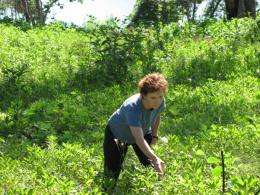Kudzu crusade

A controlled burn licked its way across 42 acres on the Oak Ridge Reservation as Oak Ridge National Laboratory's Natural Resources Management Team completed another step towards eliminating kudzu, an invasive exotic species that had overtaken the area.
Having just spent three years carefully treating the large kudzu-covered area at Gallaher Bend with foliar herbicide, the deadened kudzu vines were ready for drastic measures. With the help of the Tennessee Division of Forestry, the area was set aflame.
Kitty McCracken, the newest member of ORNL's Natural Resources Management Team who deals with invasive plant species, said kudzu is one of the biggest problems on the reservation.
"The site at Gallaher Bend was way out of control when we identified it as a place of treatment," she said. "There was a whole hillside just covered." Kudzu was brought to the United States from Asia to help control soil erosion, but the exotic plant that was meant to solve problems has only caused more.
Unlike all native species, which are bound by the local ecosystem and forced to compete with one another for resources, kudzu has no natural equals. With no native predators and the innate ability to outcompete other U.S. plants, kudzu grows rampant, making it one difficult pest to eliminate.
"Kudzu is not something that you can kill in one season," McCracken said. "You really have to gradually knock it back."
Though the fire removed a good portion of the kudzu at the Gallaher Bend site, ORNL's team is still trying to clear the kudzu vines that survived the flames. Already, additional treatment has been arranged to ensure that it doesn't overwhelm the site again.
ORNL's team has hired a ground crew to eliminate the surviving kudzu vines. Workers use a routine known as "hack and squirt," where they walk through the burned area using machetes to cut any live vines. They then spray herbicides on the cut stumps, further preventing the regrowth of kudzu.
ORNL's team is required by federal law, specifically the Federal Plant Protection Act of 2000 and Executive Order 13112, to control any invasive pest plants that live on the Oak Ridge Reservation, but there is more that motivates McCracken and colleagues.
"It's doing the right thing, really," McCracken said. "Humans have been the biggest problem globally for transporting these invasive plants, either on purpose or accidentally, so I think we sort of owe it to ourselves and the world to try to control them and maintain biodiversity."
Kudzu is causing problems all across the southern United States. Its rapid growth and vine-like behavior can strangle the most healthy of trees and pull down the most sturdy of power lines.
A study conducted this past year by the Tennessee Exotic Pest Plant Council predicts that the cost of controlling invasive plants in Tennessee alone could exceed hundreds of thousands of dollars annually.
Every year, ORNL's Natural Resources Management Team oversees the treatment of hundreds of acres on the Oak Ridge Reservation. "It's a huge effort," McCracken said. "It's gone on for a number of years and will continue to go on."
Since the burn in early spring, the 42-acre Gallaher Bend site has been slowly rebuilding into a natural habitat. Native plants have started to reclaim the area, and ORNL's team plans to let nature take its course. However, in wide-open areas that have trouble naturally regenerating, the team will plant native grasses and other plants native to this Tennessee habitat to assist in the restoration process. When McCracken drives through the 35,000-acre reservation, she can see where she and her colleagues have killed off the invasive species, which reminds her that ORNL's team is always fighting the good fight.
Provided by Oak Ridge National Laboratory















